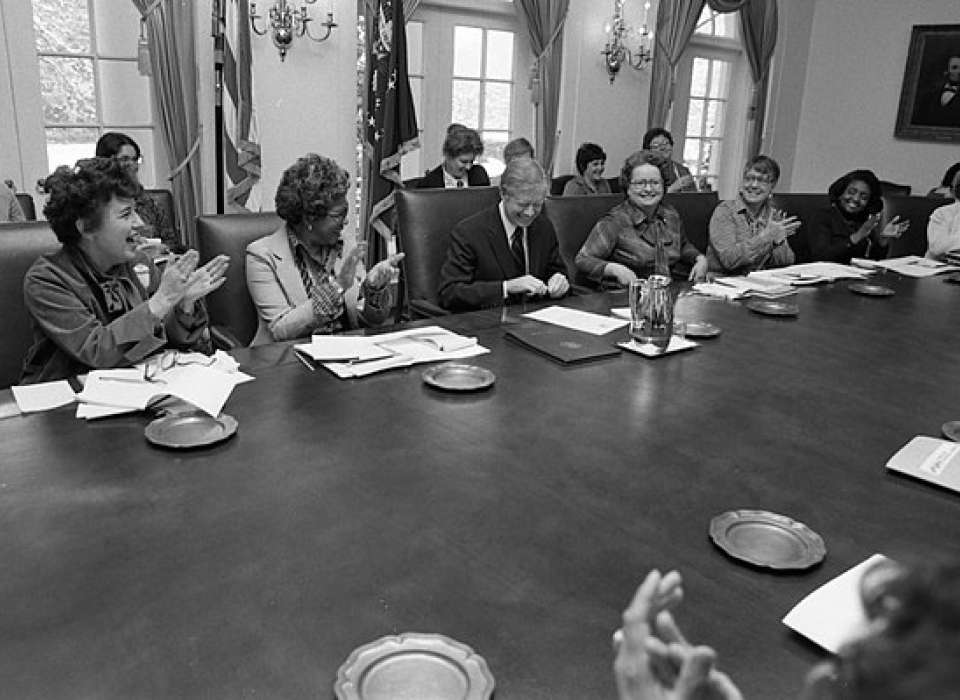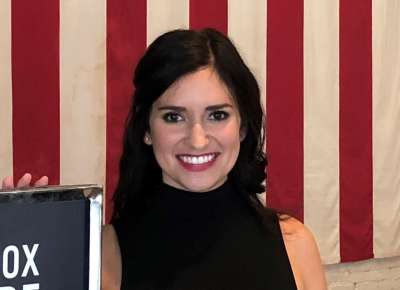Top image: Source: “President Jimmy Carter Signs Proclamation Creating National Women’s History Week,” February 27, 1980, White House Staff Photographers Collection, Series: “Jimmy Carter's Presidential Photographs,” 1/20/1977-1/20/1981, available at https://catalog.archives.gov/id/135843911.
“Women’s history is a women’s right—an essential, indispensable heritage from which we can draw pride, comfort, courage, and long-range vision.”— Gerda Lerner
The origins of Women’s History Month date back to 1978 in Santa Rosa, California, when the Education Task Force of Sonoma Country Commission on the Status of Women planned a “Women’s History Week” celebration during the week of March 8 to correspond with International Women’s Day. Led by Molly Murphy McGregor, a local teacher in Santa Rosa, the weeklong celebration highlighted women’s contributions to American history, culture, and society through presentations at dozens of schools throughout Sonoma County, California. Additionally, hundreds of students participated in an essay contest honoring local women, and the organization hosted a parade in downtown Santa Rosa.
Although the 1978 event was not intended to become an annual celebration, the following year, communities across the country organized their own women’s history celebrations. In July of the same year, historian Gerda Lerner chaired a 15-day conference on women’s history at Sarah Lawrence College, which was co-sponsored by the Women’s Action Alliance and the Smithsonian Institution. After the conference, historians and women’s activist groups began working together to lobby for a National Women’s History Week.
Their efforts proved successful when, in February 1980, President Jimmy Carter issued the first Presidential Proclamation declaring the week of March 2–8, 1980, as National Women’s History Week. In Carter’s message to the nation, he stated,
“From the first settlers who came to our shores…men and women have worked together to build this nation. Too often the women were unsung, and sometimes their contributions went unnoticed. But the achievements, leadership, courage, strength, and love of the women who built America was as vital as that of the men whose names we know so well.”
In 1981, Senator Orrin Hatch (R-Utah) and Representative Barbara Mikulski (D-Maryland) co-sponsored the first Joint Congressional Resolution, known as Pub. L. 97-28. The resolution, stated:
““Whereas American women of every race, class, and ethnic background helped found the Nation in countless recorded and unrecorded ways as servants, slaves, nurses, nuns, homemakers, industrial workers, teachers, reformers, soldiers, and pioneers; Whereas American women have played and continue to play a critical economic, cultural, and social role in every sphere of our Nation’s life by constituting a significant portion of the labor force working in and outside of the home; Whereas American women have played a unique role throughout our history by providing the majority of the Nation’s volunteer labor force and have been particularly important in the establishment of early charitable philanthropic and cultural institutions in the country; Whereas American women of every race, class, and ethnic background served as early leaders in the forefront of every major progressive social change movement, not only to secure their own right of suffrage and equal opportunity, but also in the abolitionist movement, the emancipation movement, the industrial labor union movement, and the modern civil rights movement; and Whereas despite these contributions, the role of American women in history has been consistently overlooked and undervalued in the body of American history: Now, therefore, be it Resolved by the Senate and House of Representatives of the United Women’s States of America in Congress assembled, That the week beginning History Week. March 7, 1982, is designated as ‘Women's History Week.”
Congress approved the resolution on August 4, 1981, and requested that President Ronald Reagan issue a proclamation calling upon the people of the United States to observe “Women’s History Week” with “appropriate ceremonies and activities.” Throughout the next several years, Congress repeatedly passed joint resolutions designating a week in March as “Women’s History Week,” prompting schools and women’s organizations across the country to host their own celebrations and commemorations.
In 1987, after being petitioned by the National Women’s History Project (NWHA), a non-profit organization dedicated to honoring and preserving women’s history, Congress passed Pub. L. 100-9, which proclaimed March 1987 as “Women’s History Month.” Since 1988, Congress and the president have annually issued resolutions and proclamations declaring March as Women’s History Month. According to the NWHA, “These proclamations celebrate the contributions women have made to the United States and recognize the specific achievements women have made over the course of American history in a variety of fields.”
Women in World War II
The importance of women during World War II cannot be understated. During the war, more than 19 million American women were employed in the workforce, and 350,000 women served in the US Armed Forces. Outside of the United States, women also served their nations in a myriad of ways. For a comprehensive narrative of the various roles women played during World War II, see the following book list:
- Annette Dumbach and Jud Newborn, Sophie Scholl and the White Rose, (Oneworld Publications, 2018).
- Charity Adams Earley, One Woman's Army: A Black Officer Remembers the WAC, (Texas A&M University Press, 1995).
- Mari K. Eder, The Girls Who Stepped Out of Line: Untold Stories of the Women Who Changed the Course of World War II, (Sourcebooks, 2022).
- Celia Lee and Paul Strong, Women in War: From Home Front to Front Line, (Pen and Sword Military, 2012).
- Evelyn Monahan and Rosemary Neidel-Greenlee, And If I Perish: Frontline U.S. Army Nurses in World War II, (Anchor Books, 2004).
- Sarah Rose, D-Day Girls: The Spies Who Armed the Resistance, Sabotaged the Nazis, and Helped Win World War II, (New York: Crown Publishing Group, 2019).
Jennifer Popowycz, PhD
Jennifer Popowycz, PhD is the Leventhal Research Fellow at The National WWII Museum. Her research focuses on the Eastern Front and Nazi occupation policies in Eastern Europe in World War II.
Cite this article:
MLA Citation:
APA Citation:
Chicago Style Citation:






![Max Fuchs, New York City cantor, sings as Rabbi Sydney [sic] Lefkowitz, Richmond, VA, conducts the first Jewish services from Germany.](/sites/default/files/styles/max_650x650/public/2025-10/image1.jpg)


